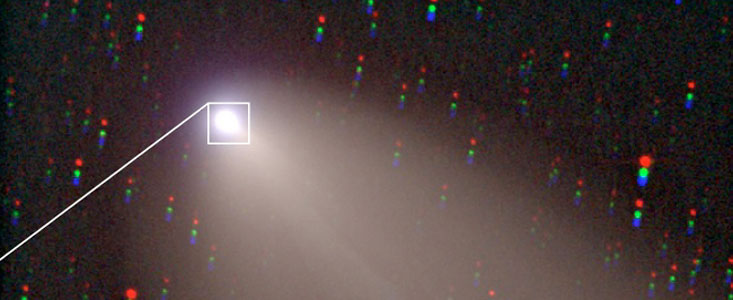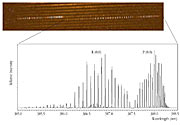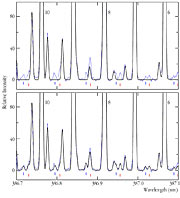Press Release
Optical Detection of Anomalous Nitrogen in Comets
VLT Opens New Window towards Our Origins
12 September 2003
A team of European astronomers [1] has used the UVES spectrograph on the 8.2-m VLT KUEYEN telescope to perform a uniquely detailed study of Comet LINEAR (C/2000 WM1) . This is the first time that this powerful instrument has been employed to obtain high-resolution spectra of a comet. At the time of the observations in mid-March 2002, Comet LINEAR was about 180 million km from the Sun, moving outwards after its perihelion passage in January. As comets are believed to carry "pristine" material - left-overs from the formation of the solar system, about 4,600 million years ago - studies of these objects are important to obtain clues about the origins of the solar system and the Earth in particular. The high quality of the data obtained of this moving 9th-magnitude object has permitted a determination of the cometary abundance of various elements and their isotopes [2]. Of particular interest is the unambiguous detection and measurement of the nitrogen-15 isotope. The only other comet in which this isotope has been observed is famous Comet Hale-Bopp - this was during the passage in 1997, when it was much brighter than Comet LINEAR. Most interestingly, Comet LINEAR and Comet Hale-Bopp display the same isotopic abundance ratio, about 1 nitrogen-15 atom for each 140 nitrogen-14 atoms ( 14 N/ 15 N = 140 ± 30) . That is about half of the terrestrial value (272). It is also very different from the result obtained by means of radio measurements of Comet Hale-Bopp ( 14 N/ 15 N = 330 ± 75). Optical and radio measurements concern different molecules (CN and HCN, respectively), and this isotopic anomaly must be explained by some differentiation mechanism. The astronomers conclude that part of the cometary nitrogen is trapped in macromolecules attached to dust particles.
The successful entry of UVES into cometary research now opens eagerly awaited opportunities for similiar observations in other, comparatively faint comets. These studies will provide crucial information about the detailed composition of a much larger number of comets than hitherto possible and hence, more information about the primordial matter from which the solar system formed. A better understanding of the origins of the cometary material (in particular the HCN and CN molecules [3]) and the connection with heavier organic molecules is highly desirable. This is especially so in view of the probable rôle of comets in bringing to the young Earth materials essential for the subsequent formation of life on our planet.
Cometary material
Knowledge of the abundance of the stable isotopes [2] of the light elements in different solar system objects provides critical clues to the origin and early evolution of these objects and of the system as a whole.
In order to gain the best possible insight into the origins and formation of the niche in which we live, it is therefore important to determine such isotopic abundance ratios in as many members of the solar family as possible. This is particularly true for comets, believed to be carriers of well-preserved specimens of the pristine material from which the solar system was made, some 4,600 million years ago.
However, the detailed study of cometary material is a difficult task. Measurements of isotopic ratios is an especially daunting undertaking, mainly because of the extreme weakness of the spectral signatures (emissions) of the less abundant species like carbon-13, nitrogen-15, etc..
Measurements of microwave emission from those atoms suffer from additional, inherent uncertainties connected to the much stronger emission of the more abundant species. Measurements in the optical spectral region thus take on particular importance in this context. However, it is exceedingly difficult to procure the high-quality, high-resolution spectra needed to show the very faint emissions of the rare species.
So far, they were only possible when a very bright comet happened to pass by, perhaps once a decade, thereby significantly limiting such studies. And there has always been some doubt whether the brightest comets are also truly representative of this class of objects.
Observations of fainter, more typical comets had to await the advent of powerful instruments and telescopes.
First UVES spectrum of a comet
Observations of Comet LINEAR (C/2000 WM1) were carried out with the UV-Visual Echelle Spectrograph (UVES) mounted on the 8.2-m VLT KUEYEN telescope at the ESO Paranal Observatory (Chile) on four occasions during March 2002. At that time, the comet had moved past its perihelion and was by far the faintest comet for which such a detailed spectral analysis had ever been attempted.
A number of 25-min exposures were secured, resulting in a total observing time of about 4 hours. The final spectrum covers the entire visual region (330 - 670 nm) and is one of the most detailed and information-rich cometary spectra ever obtained. ESO Press Photo eso0329 displays a small part of this spectrum.
These observations are the first high resolution spectra of a comet taken with the VLT.
Identification of nitrogen-15
At the time of the VLT observations, the comet was of 9th magnitude, i.e. about 15 times fainter than what can be perceived with the unaided eye. The distance from the Sun was about 180 million km; the distance from the Earth was 186 million km. The observations included calibration spectra of sunlight reflected from the lunar surface; they were used to "subtract" the solar signatures in the comet's spectrum, caused by reflection of sunlight from the dust particles around the comet.
As expected, in addition to emission from "normal" CN-molecules (12 C 14 N), the UVES data also show emission lines of the 13 C 14 N-molecule that contains the rare isotope carbon-13. The derived 12 C/ 13 C isotopic ratio is 115 ± 20, quite similar to the "standard" solar system value of 89.
However, there is also a series of weak features that are positioned exactly at the theoretical wavelengths of emission lines from 12 C 15 N-molecules, cf. ESO Press Photo eso0329 . The excellent fit that is evident in this diagram proves beyond any doubt the presence of nitrogen-15 in Comet LINEAR and allows a quite accurate determination of the isotopic ratio.
The "anomalous" nitrogen isotope ratio in comets
In 1997, the same group of astronomers obtained spectra of the (at that time) much brighter Comet Hale-Bopp with the 2.6-m NOT telescope (Roque de los Muchachos Observatory, La Palma, Canary Islands, Spain) in order to investigate the isotopic ratio of carbon-12 to carbon-13. Claude Arpigny remembers: " Interestingly, our spectra of Hale-Bopp showed a number of weak and unidentified emission lines. We later realised that they were positioned close to the theoretical wavelengths of some lines from the 12 C 15 N-molecule. This was a pleasant surprise, as lines from that molecular species were previously believed to be so faint that they would not be observable."
He continues: "This identification is now fully confirmed with the UVES observations of Comet LINEAR. Our detections in these two comets are the first ever of those emission lines in comets ".
The estimates of the 14 N/ 15 N isotopic ratios are very similar, 140 ± 35 for Hale-Bopp and 140 ± 30 for LINEAR. These ratios are remarkably low and different from the terrestrial value of 272. This means that these comets have comparatively more nitrogen-15 than has the Earth. No measurement has yet been made of the abundance of nitrogen-15 in the Sun.
So which of the values corresponds to the composition of the material from which the solar system was made?
Different origins?
To date, only four cometary values of the 14 N/ 15 N isotopic ratio have been reported: two in the radio wavelength range and the two now measured by means of optical spectra.
The radio measurements concern the HCN-molecule (hydrocyanic acid) in Comet Hale-Bopp, a "parent" molecule for the CN-molecules present in comets. Contrary to the optical measurements, the radio values (about 330 ± 75) are compatible with the terrestrial value (272). But radio measurements of carbon and nitrogen isotopic ratios are only possible on extraordinarily bright comets like Hale-Bopp, and even then, the achievable accuracy is very limited. This emphasizes the importance of performing this kind of research by means of optical observations.
The origin of the isotopic discrepancy between different CN parents is likely due to fractionation mechanisms in the forming presolar nebula, e.g. when oxygen- and carbon-bearing molecules in high-density nebulae stick to cold (10K) dust grains.
Macromolecules in space
The astronomers think that the new results indicate that the HCN-molecule cannot be the only "parent" of the CN-molecule; the latter must also be produced by some as yet unknown parent(s) in which the nitrogen-15 isotope is even more abundant.
In this connection, it is very interesting that an "excess" of nitrogen-15 is also known to exist in interplanetary dust particles (IDPs), captured by high-flying aircraft in the Earth's atmosphere. They represent the oldest material in the solar system that can be subjected to detailed laboratory analysis. Many of these particles are thought to originate from passing comets - this possibility is obviously supported by the new measurements.
The nitrogen-15 carriers in IDPs have not been securely identified but are possibly organic macromolecules or polycyclic aromatic hydrocarbons (PAHs). It is thus possible that the additional parent(s) of cometary CN may belong to this ensemble of organic substances.
Whatever the case, the longstanding question of nitrogen and its isotopic ratio(s) in the solar system, whether present and primordial, is notoriously enigmatic in several respects. However, the present results demonstrate that a detailed study of comets may deliver very useful clues.
The team has now been granted more observing time with UVES and KUEYEN in order to pursue this important study by observing more comets.
Notes
[1] The team consists of Claude Arpigny, Jean Manfroid and Damien Hutsemékers (Institut d'Astrophysique et de Géophysique de l'Université de Liège (IAGL), Belgium), Emmanuël Jehin (ESO-Chile), Rita Schulz (ESA/RSSD, Noordwijk, The Netherlands), Joachim A. Stüwe (Leiden Observatory, The Netherlands), Jean-Marc Zucconi (Observatoire de Besançon, France) and Ilya Ilyin (University of Oulu, Finland).
[2] Different isotopes of the same elements have different numbers of neutrons in their nuclei. For instance, carbon-12 nuclei contain six protons and six neutrons (i.e., 12 particles in all) - this is the most abundant carbon isotope; carbon-13 contains six protons and seven neutrons. Nitrogen-14 - the most abundant isotope of this element - has seven protons and seven neutrons; nitrogen-15 has seven protons and eight neutrons.
[3] In chemical terms, CN is referred to as a "radical".
More information
The results described in this ESO press release are presented in a research report published today in the "Science" journal ("Anomalous Nitrogen Isotope Ratio in Comets", by Claude Arpigny and co-authors). The Liège University is also issuing a press release (in French) on this occasion.
Contacts
Claude Arpigny
Institut d'Astrophysique et de Géophysique, Université de Liège
Liège, Belgium
Tel: +32 (0)4 366 97 12
Email: arpigny@astro.ulg.ac.be
Emmanuël Jehin
ESO
Santiago, Chile
Tel: +56 2 463 30 65
Email: ejehin@eso.org
About the Release
| Release No.: | eso0329 |
| Legacy ID: | PR 25/03 |
| Name: | C/2000 WM1 (LINEAR), Comet LINEAR |
| Type: | Solar System : Interplanetary Body : Comet |
| Facility: | Very Large Telescope |
| Instruments: | UVES |
| Science data: | 2003Sci...301.1522A |



